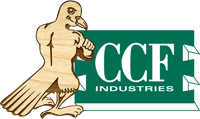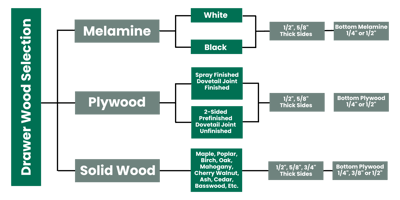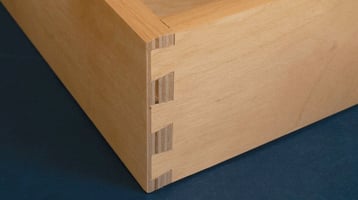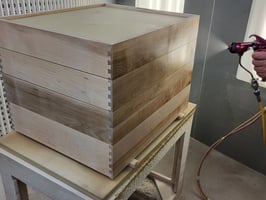10 Things That Can Go Wrong When Sourcing Dovetail Drawers & How We Get Them Right for You
When sourcing dovetail drawers, it’s critical to work with a reliable manufacturing partner so you can achieve optimal drawer quality and meet your production and delivery schedules. Given the number of variables involved in drawer manufacturing, some snafus can occur during design and production. At CCF Industries, we work tirelessly to prevent them from happening, and being aware of those potential difficulties, and how to avoid or overcome them, can make you better prepared to work with a manufacturing partner.
 With apologies to Dr. Seuss, author of The Cat in the Hat, which you may remember has two ill-behaved characters named Thing 1 and Thing 2 (Bim and Ben), here is a comprehensive list of potential hazards and explanations of how we can help you avoid them.
With apologies to Dr. Seuss, author of The Cat in the Hat, which you may remember has two ill-behaved characters named Thing 1 and Thing 2 (Bim and Ben), here is a comprehensive list of potential hazards and explanations of how we can help you avoid them.
Thing 1: Not following drawings or specifications. When drawings or specifications are not followed, the product is likely to not fit or function properly, causing delays in fixing the problem, annoying the customer, and costing the manufacturer valuable time and money.
 At CCF, we prevent this problem from occurring by reviewing all drawings carefully. If there are questions or concerns, we contact the customer immediately to verify the specifications. Some of the unusual questions we have had to resolve are measurements not adding up in divider drawers and unreadable dimensions.
At CCF, we prevent this problem from occurring by reviewing all drawings carefully. If there are questions or concerns, we contact the customer immediately to verify the specifications. Some of the unusual questions we have had to resolve are measurements not adding up in divider drawers and unreadable dimensions.
Thing 2: Production equipment malfunctions and produces a drawer that does not meet specifications. Unscheduled employee call-offs, unexpected machine breakdowns, human error, and power outages can contribute to the production of “defective” drawers.
Our preventive maintenance program and a spare parts inventory for wear items on our machinery help to make equipment malfunctions rare in our shop. Additionally, our staff is cross-trained to operate equipment and otherwise divide labor at a moment’s notice when a team member is absent from work.
 Thing 3: Drawer quality is unacceptable due to ill-fitting joints, bad finishes, or other factors. With product quality always on everyone’s radar, many things can be unacceptable, such as checking in the wood, delamination of plywood, bad glue seams, rough finish, and out-of-square. These deficiencies result from human error more often than from malfunctioning equipment.
Thing 3: Drawer quality is unacceptable due to ill-fitting joints, bad finishes, or other factors. With product quality always on everyone’s radar, many things can be unacceptable, such as checking in the wood, delamination of plywood, bad glue seams, rough finish, and out-of-square. These deficiencies result from human error more often than from malfunctioning equipment.
We avoid quality problems by making quality everyone’s job so our dovetail drawers match customer specifications exactly time after time. Our team members are skilled at knowing what quality means in our shop because they are trained to be observant and are not afraid to ask questions of more experienced team members.
Thing 4: Standard Drawer Boxes and Value Drawers are manufactured incorrectly. When it comes to producing Standard Drawer Boxes, human error such as incorrect measurement and cutting, equipment malfunctions, and clerical errors such as incorrect information entering the system online or in our office can cause re-work and delays. Additionally, our Value Drawers have a foil top edge that sometimes does not adhere properly.
We minimize human error by continually training our team members to be detail-oriented because the cost of making mistakes can be high. As for the foil use, we make certain that we use quality foil and that our operator monitors the heat, pressure, and alignment on the machine, as well as fills voids and re-foils them as necessary.
Thing 5: Custom Drawer Boxes are manufactured incorrectly. When customers do not supply drawings, or the drawings are inaccurate, or the customer is not clear about what they need, or someone on the production team does not follow specifications, re-work and production delays occur.
When we receive an order, we review drawings and contact the customer to get more information, if needed.
Thing 6: Packaging and shipment of drawers is done incorrectly. The most common shipping-related issue is damage caused by carriers, and you have likely seen YouTube videos of how roughly freight is sometimes handled.
 Our “workaround” to this ongoing challenge is taking extra time to prepare our drawers for shipping with the assumption that they will get “abused” in transit. This approach includes using protective corners on our ground-shipped packages and Gaylord boxes, which are large, corrugated cardboard containers (48”x40”x36”) designed for use on pallets. We pack the drawers as tightly as possible and then wrap the box with stretch wrap and fasten it to the pallet with nylon strapping material.
Our “workaround” to this ongoing challenge is taking extra time to prepare our drawers for shipping with the assumption that they will get “abused” in transit. This approach includes using protective corners on our ground-shipped packages and Gaylord boxes, which are large, corrugated cardboard containers (48”x40”x36”) designed for use on pallets. We pack the drawers as tightly as possible and then wrap the box with stretch wrap and fasten it to the pallet with nylon strapping material.
Thing 7: Warehousing of drawers for future use is done carelessly. Accumulation of dust and debris from sitting around too long and the risk of accidental damage from other products being manufactured and stored contribute to storage-related problems. If the product is not stored in a climate-controlled room, shrinking or swelling may occur, making the drawers become out of spec.
Although we do not warehouse drawers often because everything we manufacture is made-to-order and shipped upon completion, when we warehouse drawers, we protect them in a climate-controlled area of our facility.
Thing 8: An order is placed verbally instead of in writing. When nothing is written down, dimensions, divider locations, and other details can be misinterpreted or missed altogether, creating an awful situation for everyone involved.
 To prevent this time-consuming and costly occurrence, we prefer to not take verbal orders or confirmations. Our online ordering system allows customers to input orders and attach photos or drawings as necessary to give us a complete understanding of their drawer box orders.
To prevent this time-consuming and costly occurrence, we prefer to not take verbal orders or confirmations. Our online ordering system allows customers to input orders and attach photos or drawings as necessary to give us a complete understanding of their drawer box orders.
If we take a verbal order, we enter the information in a quote and send it to the customer by email or fax so the customer can approve the quote before we send the order into production. Likewise, if we receive an online order and something is unclear, we will reach out to the customer for clarification before we begin production.
Thing 9: An order is not confirmed upon submission. On an extremely busy day, orders can be buried deep in email communication or otherwise “lost” or overlooked.
Our policy is to send an email confirmation when we receive an order. We then send a second email confirmation when the order is verified and we have assigned an estimated shipping date to the order.
Thing 10: Invoicing and accounts receivable activities do not go smoothly. With customers nationwide having similar or identical company names, the wrong customer can be billed. Other road bumps include customers needing more time to pay their invoices or wanting to use multiple types of payment forms for a single transaction, and cybersecurity and physical (postal) security considerations.
To make billing and payments as seamless as possible, we verify the customer’s billing address and contacts at the time of account setup. To ensure that our customers have maximum payment options, we accept all major credit cards, ACH payments, and checks. We extend Net 30 terms to our customers upon the completion and approval of credit applications. We also use multiple layers of cybersecurity to keep our customers’ information safe. We also work with an IT expert who has enabled us to adopt the industry’s best cybersecurity practices.
Out-of-the-Box Ways to Help You Stay On-Track
 A combination of strict attention to detail by well-trained team members who are passionate about their work along with an ordering system that requires written specifications and related descriptions about product features, and a strict order verification process, help to prevent quality problems that can result in production delays.
A combination of strict attention to detail by well-trained team members who are passionate about their work along with an ordering system that requires written specifications and related descriptions about product features, and a strict order verification process, help to prevent quality problems that can result in production delays.
When looking for a drawer manufacturing partner, it is important to make sure the partner follows best practices on the shop floor and in the back office. To see if we’re a good fit…





